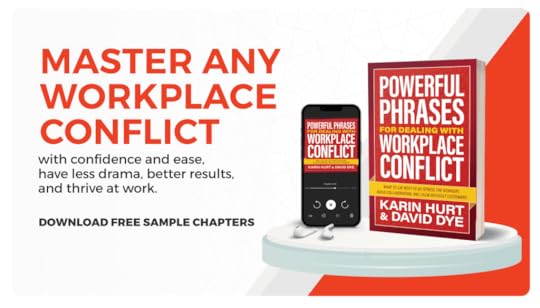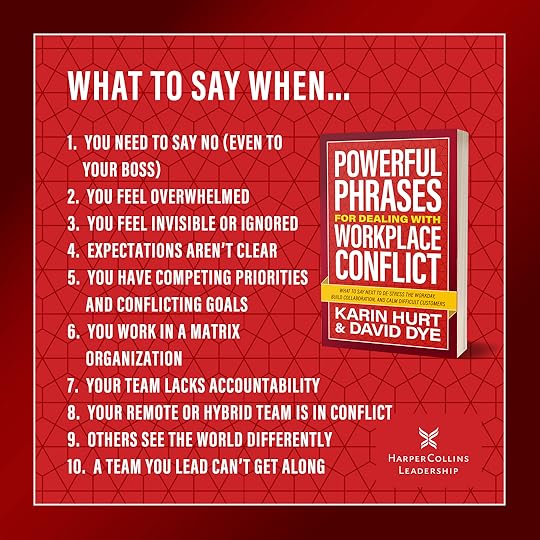David Dye's Blog, page 21
April 29, 2024
Transforming Tension: How to Embrace the Benefits of Workplace Conflict
No one needs destructive, anger-fueled conflict at work. It’s corrosive and makes work miserable. But there’s another kind of workplace conflict that’s not only vital for a vibrant culture, but this kind of productive workplace conflict is also the fuel for innovation, quality of life, and the better workplace today’s teams crave.
Who Wants More Conflict at Work?In our World Workplace Conflict and Collaboration Survey we asked over 5000 people in 45+ countries about their experiences with workplace conflict. 70% of respondents said they’re experiencing the same or more conflict at work than just a few years ago.
But when you look into the 30% who say they have less conflict at work, half of those say the reason they’re experiencing less conflict is that they’ve hit the escape button. They said left a conflict-prone workplace. They told us they’re working from home and avoiding people.
And that might sound good—after all, who wants more conflict at work? Well, the answer is—we should all want…if not more, at least better, conflict at work.
To see why, let’s dive a little deeper into another question. We asked about the consequences of conflict at work. And many of the negative consequences you would expect were top of mind: stress (55%), employees leaving (33%), reduced productivity (30%).
But also on the list of consequences were:
Improved quality of work (12%)Positive policy change (10%)More innovation or creativity (8%)And these are just a few of the reasons you might need more conflict, not less, in your workplace.
4 Benefits of Workplace ConflictOne way to look at workplace is that the question isn’t ultimately about the quantity of conflict, it’s about what kind of conflict you have.
Most of the time, when people think of conflict, they immediately think of intense argument resulting in anger at one another, the silent treatment, or other forms of social violence (like shunning, discrimination, or harassment).
But with the right tools, conflict can also produce a much more pleasant workplace that’s more inclusive and does a better job serving its clients or customers.
Here are just a few benefits of productive workplace conflict:
1. Improved WorkplaceThink about the values that guide your workplace. No matter what those values are, the values will conflict with one another at some point. Radical flexibility might come up against serving the customer with excellence. Now what?
These are productive conflict conversations that every high-performing culture will explore. As you have these conversations, you and your team can act more often in alignment with your values. You can change policies that don’t align with your values.
And you’ll have better relationship because trust is built on connection, credibility, reliability, and knowing that you have one another’s best interest at heart. Meaningful conversations that explore different perspectives and approaches improve all of these relationship-building attributes
2. More (and more effective) SolutionsHere are 12 Powerful Phrases to help your team genuinely connect and increase understanding.
When you and your team can safely challenge one another’s assumptions, you open yourself to a much larger and meaningful source of answers to your problems.
Your first solution is almost never as good as it could be with some exploration, revision, and poking holes. Invite the conflict – ask people to challenge your thinking. Show you what you haven’t considered. And create better solutions together.
3. Smarter TeamsHere are 12 Powerful Phrases to help your team show up with more curiosity.
Expectation violations are one of the biggest sources of workplace conflict. Each of us have understandings of the way the world works and we put those assumptions on other people. And of course, they won’t live up to them. How could they? They don’t even know the expectation exists.
Sometimes YOU don’t even know you have the expectation until somebody violates it.
Digging deeper when expectation violations hit will increase clarity. Actively seeking different perspectives helps you view problems from many directions and make more efficient and meaningful choices.
Speaking up with the information that only you have gives others a chance to make smarter, more informed decisions.
All that increased clarity makes everyone smarter.
4. Better WorkHere are 12 Powerful Phrases to help your team invest in greater clarity.
Combine those first three benefits of a better workplace, more solutions, and smarter teams and you can’t help but do better work.
Building trusted relationships, examining how you’re doing your work, and creating freedom to evaluate what doesn’t make sense gives everyone a chance to reduce waste, decrease avoidable employee turnover, and eliminate unintentionally destructive systems that undermine your culture.
Make Me SmarterHere are 12 Powerful Phrases to help your team create and keep meaningful agreements.
If, despite all these benefits, you still hesitate to approach conflict situations with curiosity, or worry about “losing” to someone else’s perspective, one way to overcome your hesitation is to focus on getting smarter.
What if you approached every disagreement as an opportunity to become smarter? Instead of looking at your colleague, boss, or team member as an obstacle, what if, instead, you asked them to make you smarter?
You might not say the words aloud (though you certainly could if you have a good relationship) but entering the conversation with the assumption that the other person has something that will make you smarter is a powerful way to sidestep that troublesome insistence on being right.
Your TurnThese are just a few of the benefits of productive workplace conflict.
We’d love to hear from you: What would you add? Have you been part of a conflict that you are grateful for? What made it productive?
The post Transforming Tension: How to Embrace the Benefits of Workplace Conflict appeared first on Let's Grow Leaders.
April 26, 2024
From Confusion to Clarity: Addressing Unclear Expectations
Episode 254: In this episode, host David Dye delves into the pervasive challenge of addressing unclear expectations in the workplace. David unpacks how such ambiguity can be the root of workplace conflict and offers precise language to help you articulate concerns and seek mutual understanding. For instance, in situations like deciding if turning on the camera during virtual meetings is necessary, phrases like “It appears we have different perspectives on this” can pave the way for open dialogue. David also highlights the importance of establishing decision-making processes within teams, whether by majority vote or reaching a consensus. Tune in for insightful strategies on transforming confusion into clarity and don’t hesitate to reach out to David with your questions or specific situations for future discussions.
Mastering the Art of Addressing Unclear Expectations at Work00:00 – Navigating Unclear Expectations At the start, David introduces us to the theme of the day: addressing unclear expectations at work. He emphasizes the prevalence of this issue and assures listeners that they’re not alone in facing it.
00:58 – The Conflict of Confusion David speaks to the heart of workplace confusion and conflict. He mentions the book “Powerful Phrases for Dealing With Workplace Conflict” as a resource for over 300 phrases to defuse these situations.
01:48 – Share Your Challenges Listeners are encouraged to contribute their own conflicts or questions related to unclear expectations, offering a chance for them to be featured in future episodes.
Proven Strategies for Resolving Lack of Clarity in the Workplace02:58 – The Virtual Meeting Dilemma Using the example of whether to have cameras on during remote meetings, David illustrates how unclear expectations can lead to conflict among team members.
03:49 – Crafting Clear Norms David discusses the importance of establishing norms to address situations where company policies don’t provide guidance, preventing this lack of clarity from becoming a source of conflict.
04:42 – Four Dimensions to Tackle Unclear Expectations He revisits the four dimensions of workplace conflict and collaboration, highlighting the importance of clarity in resolving unclear expectations.
05:30 – Phrases for Clarity David introduces specific phrases to use when expectations are not clear, such as acknowledging differing views as a starting point for discussion.
06:36 – Rallying the Team To combat unclear expectations, David suggests phrases that align the team towards a common goal and encourage a collective approach to finding solutions.
07:14 – Employing Curiosity David advocates for the use of curiosity. Asking questions to gain a deeper understanding of each team member’s perspective.
08:12 – Deciding Together The episode closes with an emphasis on decision-making processes, suggesting that teams should agree on how to make decisions.
The post From Confusion to Clarity: Addressing Unclear Expectations appeared first on Let's Grow Leaders.
Lead Through Change: How to Guide Your Team to Success
“Hey Karin, I need some help leading through change. My team LOVES doing things the WAY THEY’VE ALWAYS DONE THEM. And I’m trying to get them to embrace some new technology. To do things just a little bit differently. But they are comfortable where they are. What should I do? #AskingforaFriend

Your Curiosity Powerful Phrases are a great start here. You can’t go wrong with your curiosity G.O.A.T.s. You can download a FREE G.O.A.T. Job Aid at our Conflict and Collaboration Resource Center.
“I’m curious how this looks from your perspective?”
“How can I best support you right now?”
Or try these.
“I’m really curious, what is your biggest concern about this change?”
“What would your work day look like if we were to adopt this change? What are you afraid of losing?”
When helping a team adapt to change, another tried and true technique is a Force Field Analysis (Kurt Lewin). Invite your team to consider all the driving forces that would make it easier to adapt to change. And then have them consider the restraining forces that would make it hard.
The magic in the conversation is the “how can we….” brainstorming. How can we leverage the driving forces and work to mitigate the restraining forces.
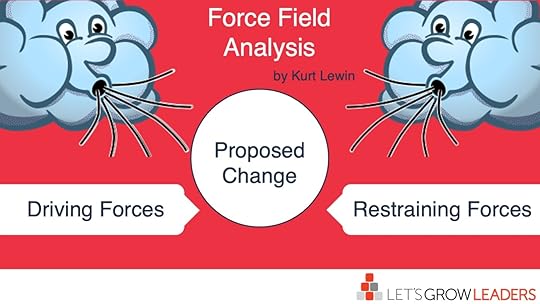
Describe the change. Clearly articulate what you want to achieve. This step sets the stage for the analysis and helps ensure everyone involved understands the goal.
Step 2: Brainstorm ForcesSplit the team into smaller groups, if necessary, and brainstorm the forces driving change (positive forces) and those resisting change (negative forces). Encourage open and honest discussion to identify as many factors as possible.
Step 3: List ForcesOn a whiteboard or large piece of paper, draw a line down the middle to create two columns. Label one side “Driving Forces” and the other “Restraining Forces”. List all the forces identified during the brainstorming session in the appropriate columns.
Step 4: Prioritize and Score Forces (Optional)Assign a score to each force based on its strength or impact on the change. This can be a simple scale from 1 (weak) to 5 (strong). This helps to visualize which factors are most significant and which might be easier to address.
Step 5: Analyze and DiscussWith the team, discuss the forces listed. Consider how the driving forces can be strengthened or how the restraining forces can be weakened. This discussion should aim to find actionable strategies to increase the likelihood of successful change.
Step 6: Develop Action PlansBased on the analysis, develop strategies or action plans to enhance the driving forces and reduce the effects of the restraining forces. Assign responsibilities and timelines to ensure these actions are implemented effectively.
Celebrating Progress: The Power of Recognizing Small VictoriesFinally, recognizing and celebrating every small victory is vital. It reinforces positive behavior and shows that the organization values adaptability and improvement.
So, what can you add to this approach? Whether it’s a personal anecdote of a change you’ve championed or a unique technique that worked wonders, sharing these experiences can provide others with the tools and inspiration they need to lead their teams to success.
Leading through change is about more than just introducing new policies or technologies; it’s about nurturing a culture that embraces change. It’s about leveraging curiosity to foster an environment of continuous learning and growth.
The post Lead Through Change: How to Guide Your Team to Success appeared first on Let's Grow Leaders.
April 22, 2024
How to Choose the Right Communication Channel for Your Message
It’s What You Say AND How You Say It
If you’re managing a team, you know how crucial your choice of communication can be. Let’s start with a timeless piece of advice from Marshall McLuhan, the renowned communication researcher. He famously said, “The medium is the message.” What does this mean for you as a manager? It means that how you communicate with your team can be just as important, if not more so, than what you are communicating. It’s vital to chose the right communication channel for your message.
Think about this: if you decide to inform an employee that you’re going to change their schedule to an inconvenient time via a quick message on Slack, what message are you really sending? They might think, “My manager doesn’t care about me, or have my best interest at heart.” Whether or not this is true, that’s the impression your choice of medium might convey.
On the flip side, consider a scenario where you send a handwritten note to an employee expressing sincere gratitude for their hard work. This act alone might make them feel truly valued and appreciated. See? The medium really is the message.
Key Questions to Consider Before CommunicatingWhen it comes time to decide how to communicate something important, we encourage you to slow down and consider these three crucial questions:
What might it feel like to be on the receiving end? Try to understand their potential thoughts, feelings, and concerns.What do you want them to think, feel, or do as a result of this conversation? Define what a successful outcome looks like for you.What questions might they have? Be prepared to address these questions to reassure and inform.Choosing the Right Communication Channel
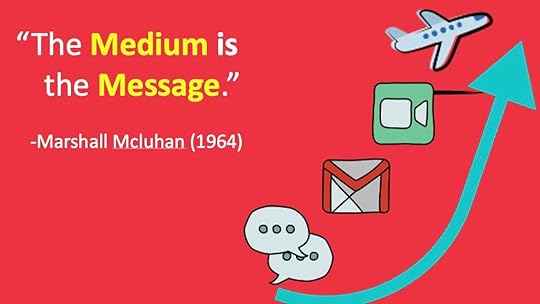
The rule of thumb here is straightforward: the more sensitive or emotional the conversation, the higher bandwidth you need. High bandwidth communications—like face-to-face meetings or video calls—allow for real-time feedback, facial expressions, and tone of voice, all of which are invaluable for complex or delicate messages.
For example, if you need to adjust the time of a team meeting, a quick message on Slack might suffice. However, if you’re about to change the strategic direction of your team, that’s a conversation that requires direct interaction. You need to see their reactions, engage in a real dialogue, and field questions on the spot. Of course, then you’ll want to follow up your conversation with 5×5 communication.
Training Managers to Choose WiselyIf you’re a manager of managers, take some time to help them think through this. Our experience is this isn’t intuitive for everyone– in fact for some managers, there’s a tendency to avoid tough conversations by using a less personal channel. One way to do this is to set up a workshop where they can work through realistic scenarios using the three questions mentioned above.
This helps them choose the right communication channel and plan the key messages they need to deliver.
Moreover, it’s crucial for building confidence among managers who might prefer hiding behind emails or chat messages because they’re nervous about having tough conversations.
The TakeawayAlways remember, when the conversation matters, the choice of how you communicate it matters just as much. Quick, one-way messages are often not sufficient for serious or complex discussions. They can lead to misunderstandings and feelings of being undervalued.
Help your managers understand which topics need more sensitive handling and guide them in establishing clear norms for choosing the appropriate communication channel. It’s all about making sure that the medium truly matches the message, ensuring that your team feels respected and valued. This isn’t just good communication; it’s good leadership.
See Also: Better Teamwork:12 Practical Team Habits To Build Better Connection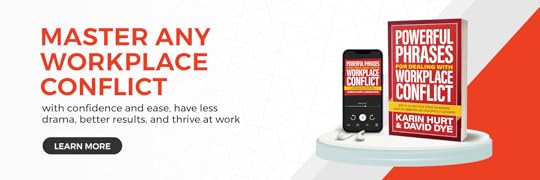
The post How to Choose the Right Communication Channel for Your Message appeared first on Let's Grow Leaders.
April 19, 2024
7 Practical Ways to Create a More Sustainable Organization
Today I talk with Cooper Wechkin Founder and CEO of RyeStrategy about the business case for a sustainable organization (even for small organizations). We discussed practical and important ways small businesses can do their part toward a more sustainable future.
“Hi Karin, I know it’s Earth Month, and I really should be thinking about sustainability but it can all feel overwhelming. Where can I start? How do I begin making an impact? #askingforafriend

The stats are showing a shift from “nice to have” to “need to have.”
Over 50% of the emissions that come from the business sector come from small businesses.80% of consumers are expecting businesses to do something about climate change.50% are willing to shift their purchasing toward more environmentally friendly options.Two-thirds of employees care about the sustainability initiatives of their company. 84% of those people think their organizations aren’t doing enough.In a recent survey, 83% of millennials reported that they’d be more loyal to a company that prioritized greener living and addressed environmental issues head-on.And if you work in the B2B space, and you are a supplier to larger companies with NET ZERO COMMITMENTS– it’s important to know that 80% of the emissions are coming from suppliers. So if they ever want to hit THEIR GOAL…However, there are simple ways to do this.
Empower Your Sustainable Organization: Seven Strategic Steps to Go GreenIgnite sustainability by fostering environmental awareness. Through collaborative learning and team activities, plant the seeds of a green mindset across your workplace.Streamline resource use through recycling programs and a switch to renewable energy sources.Trim excess energy consumption. Conduct energy audits and implement eco-friendly initiatives. Try installing smart thermostats to embracing natural lighting.Reinforce the roots of your sustainable organization with a flexible telecommuting policy. This practice nurtures work-life balance and reduces carbon footprints.Integrate water-saving techniques into your organization’s daily routine. Encourage habits to maximize every resource.Nurture your sustainable organization with ethical purchasing decisions. Select suppliers who share your green vision. Ensure that every link in your supply chain reflects your commitment to sustainability.Finally, encourage a rotational flow of innovative ideas to keep your sustainable organization’s practices fresh and effective.Your turn. Is your company working on practical ways to create a more sustainable organization?
What’s one of your favorite practices?
The post 7 Practical Ways to Create a More Sustainable Organization appeared first on Let's Grow Leaders.
Setting Healthy Boundaries: What to Say When You Need to Say No
Episode 253: In this episode of “Leadership Without Losing Your Soul,” you’re diving into the art of setting healthy boundaries and saying no at work. Imagine you’re in a sticky situation. A colleague wants you on a new project, but you’re swamped. Or maybe your boss is pushing you towards something that doesn’t align with your values. How do you push back without burning bridges? This podcast episode explores the importance of maintaining connection, being clear and curious, and staying committed to your boundaries. Host, David Dye, will share some practical phrases and strategies you can use. And if you’re hungry for more, you can check out “Powerful Phrases for Dealing with Workplace Conflict,” packed with over 300 phrases to handle these tough situations.
Establish Healthy Boundaries: Learn the Power of ‘No’ in Your Workplace00:01 – Welcome and Introduction Today, we’re diving into how you can say ‘no’ in the office without losing your cool or compromising your projects. You’re going to learn strategies not just for declining politely, but also how to maintain respect and integrity, particularly when you have to say no to your boss or turn down a tempting project.
01:02 – Check Out the Book! If you’re liking these practical ways to deal with workplace conflict, definitely check out our book, “Powerful Phrases for Dealing With Workplace Conflict.” It’s packed with over 300 phrases to help you navigate these tricky situations, available in paperback, ebook, and audio formats.
02:02 – The Importance of Connection When you need to establish healthy boundaries, remember the four dimensions of conflict and collaboration: connection, clarity, curiosity, and commitment. These will be your tools to saying no effectively while still preserving relationships.
03:04 – Saying Yes to Say No Every time you say yes to something, you’re inevitably saying no to something else. Understanding this can empower you to make decisions that reflect your true priorities and establish healthy boundaries at work.
04:23 – Practical Phrases for Declining Try phrases like, “Wow, I’m impressed with all you’re doing. I just can’t help with this right now,” to connect personally while clarifying your inability to commit.
05:18 – Managing Meeting Invitations For those endless meetings, learn to ask, “What’s the contribution you need me to make?” This helps you provide what’s essential without sacrificing your time on unnecessary attendance.
06:31 – Standing by Your Expertise When your expertise dictates a different approach, use your knowledge confidently but remain open with phrases like, “I’m confident that we should take a different approach. Here’s why, and I’m curious about your perspective.”
Navigating Office Politics: Master the Art of Saying No with Integrity07:27 – Upholding Values and Ethics Sometimes, you need to say no based on ethical concerns. Phrases like, “Nope, can’t do that. Violates our code of conduct,” are direct and uphold your professional integrity.
09:13 – How to Say No to Your Boss This is crucial for maintaining healthy boundaries. Begin with connection and clarity about the impact of their requests and propose alternative solutions that align with team goals.
11:36 – Recap and Closure Wrap up with a reminder of the power of saying no to maintain balance and focus on what’s truly important. Encourage feedback and suggest setting a dedicated time to discuss priorities and workload.
The post Setting Healthy Boundaries: What to Say When You Need to Say No appeared first on Let's Grow Leaders.
April 15, 2024
The Roadmap to Clarity: Three Must-Have Steps in Your Decision Making Process
In a world with a constantly growing AI presence, where data is cheap, and you can easily outsource routine tasks to large language models, your decision making ability plays a more vital role than ever. Your ability to help your organization and teams make effective decisions is a competitive advantage and rare leadership skill. Three questions will help energize and clarify your decision making process.
When Decision Making Meetings Go WrongYou’ve been there before. One of those awful meetings that turns into a painful slog through a swamp of half-hearted participation and conversations that go in circles.
Pretty soon someone says, “Sorry, I have to get to another call,” and everyone else looks at them with a mix of jealousy and frustration. The meeting ends with no decision made, an hour or more wasted, and the team’s morale drained from their inability to act.
When decision making meetings go wrong, one or more of these factors is usually in play:
You don’t have the right peopleYou don’t know who owns the decisionYou haven’t defined the success criteriaInvest in Clarity for Energetic Decision Making that Builds MoraleMissing clarity is at the heart of all three decision making morale busters. You can solve them by answering three key questions:
Who does this decision affect?Who owns this decision?What would a successful outcome do for each affected party?Let’s look at each of these questions.
1) Who does this decision affect?To make the best decision, make sure to include people who the decision affects in the process. You don’t need everyone. What’s the smallest group of people to get the needed input?
2) Who owns this decision?Before discussion begins, clarify the person or people who will actually make the call. There are only three options:
A single person decides (maybe you, maybe another subject matter expert)A group votesA group reaches consensus (where everyone can live with one outcome)(To learn more about clarifying who attends decision making meetings and who owns the decision check out the Advanced Guide to Lead Meetings That Get Results and People Want to Attend)
3) What would a successful outcome do for you?This final clarity question is critical to a successful decision, and yet we regularly see leaders skip it or assume that everyone has the same success criteria in mind.
But of course, they don’t, and so people talk past one another and frustration reigns.
You can’t reliably choose effective solutions if you don’t know what success looks like.
Let’s say your team is discussing a marketing opportunity with some newly available funds. If you jump into the discussion before establishing success criteria, how will you choose between different options?
Lela and Vinesh jump in, “Let’s hire actors and do a flash mob of the thriller dance. Then the zombies will transform at the end by shedding their overshirts and revealing our product tee shirt. It will be great for social!”
Mark and Sheila suggest, “We should really do one more booth at the new conference expo they just added at the end of the year. Those leads are usually solid.”
Osa and Vik listen for a moment and then add, “Let’s not limit ourselves here. There’s an opportunity for a partnership with the magic soda corp—they’re looking for someone to package with for a winter campaign.”
The conversation likely turns into a tug of war between two or three different positions who each argue for solutions that make sense to them.
The antidote to this confusion and frustration is to establish clear success criteria. If you’ve already got clear success criteria, don’t keep them a secret. Share them before anyone presents any ideas.
A Powerful QuestionBut if the criteria aren’t clear or haven’t been established for you, it’s up to you to ensure a shared understanding of what success looks like.
When you first ask key stakeholders what a successful outcome will do for them, you can build a set of success criteria that will both filter the ideas people bring to the table and then give the decision maker(s) a way to evaluate choices.
“What would a successful outcome do for you?” is one of our favorite of the G.O.A.T. (Greatest of All Time) Powerful Phrases for Dealing with Workplace Conflict because it gets underneath what people really need. Instead of arguing for their position (zombies, booth, partnership), you learn what outcomes matter most.
Use Your Criteria to Evaluate OptionsSuppose you ask the relevant stakeholders this question and get a resounding answer like, “We need to boost overall sales and leads for next year. A secondary, but important outcome is that need to improve perceived value for our existing channel partners.”
Now you’ve got some general criteria to work with. You might drive for more detail or numeric goals. But even if you get directional criteria like these, you are in a better place to evaluate options. You can ask each group to make their case relative to the success criteria in play.
Team flash mob might take zombies off the table (it would help with perceived partner value, but probably not have much effect on sales or leads.) The expo and partner-packaging folks can make their cases for both outcomes.
Before You Stop with the Options You Have…You can also ask your team to reframe the opportunity and look for alternative ways to achieve the same or better outcomes.
This can be a fun exercise: “We’ve been talking about increasing our pipeline by 3%. What if we needed to increase it by 10% with the same resources? What might we do?”
Your TurnIt might feel obvious to clarify what success looks before you get into a decision making conversation. But it happens all the time and teams waste too much valuable time and energy talking past one another. Energize your decision making conversations by clarifying who should be there, who owns the decision, and critically, what will a successful outcome achieve.
We’d love to hear from you: how do you ensure decision making criteria are clear before you get into discussions about ideas?
You Might Like:Why Your Team Can’t Innovate When You Want Ideas and Try to HelpWorkplace Innovation: The Secret to Getting Better, Remarkable, Usable IdeasHow to Train a Struggling Team Member to Make Better DecisionsThe post The Roadmap to Clarity: Three Must-Have Steps in Your Decision Making Process appeared first on Let's Grow Leaders.
April 13, 2024
Think Clarity: The Key to Highly Effective Leadership Focus (With Video)
The more challenges you face, the more clear you need to be about which problem is the most important to solve.
Today’s Asking for a Friend is with Dr Avnesh (Avi) Ratnanesan talking about the power of clarity and focus when dealing with today’s “conflict cocktails.”
His answer, figure out your ONE BIG PROBLEM TO SOLVE.
It’s tricky, right? Because there are so many problems.
But when you can define your biggest problem in one sentence, align energy and resources around it, and measure the impact, you create real CLARITY OF FOCUS AND EXECUTION.
Of course, this is vital advice for C-level leaders. But, you don’t need to be a CEO, COO, or a CHRO to use this advice.
It works at a team level too.
Asking For a Friend with Dr. Avi RatnanesanToday’s interview is a wonderful deep dive with examples about why laser leadership focus on a single problem is a fast and vital way to align everyone in your team or organization for integrated execution.

When you start with the question, ‘What is the biggest problem we face?’ You immediately focus your team’s attention on the most pressing issue.
2. How can we articulate that problem in one sentence?By articulating this problem in one clear and concise sentence, you not only make the issue more digestible but also ensure that every member of your team is on the same page and understands the exact nature of the challenge.
3. What is it costing us? (And, what’s at stake if we don’t fix it?The next crucial questions, ‘What is it costing us?’ and ‘What’s at stake if we don’t fix it?’ help you quantify the problem in terms of resources, time, and impact. This drives home the urgency and the high stakes involved.
These three questions aren’t just about identifying problems—they’re about setting a clear, focused direction for collective action. This targeted approach simplifies complexity and magnifies the significance of teamwork in overcoming obstacles.
Your turn. How do you create true leadership focus?
The post Think Clarity: The Key to Highly Effective Leadership Focus (With Video) appeared first on Let's Grow Leaders.
April 12, 2024
12 G.O.A.T. Powerful Phrases to Instantly Boost Your Communication Skills
Episode 252: In this episode, David introduces you to 12 effective phrases to help you improve your communication skills and effectively navigate workplace conflict. He organizes these phrases into four critical areas: connection, clarity, curiosity, and commitment. You’ll learn to express care and investment through phrases like, “I care about you, this team, this project.” He encourages you to seek understanding with questions such as, “What would a successful outcome do for you?” and “I’m curious how this looks from your perspective.” To keep the dialogue productive, he suggests planning follow-ups with, “Let’s schedule time to talk about this again and see how our solution is working.” These phrases are tools for deescalating tension, fostering trust, and improving decision-making. They’re also featured in David’s new book, “Powerful Phrases for Dealing with Workplace Conflict,” which offers over 300 phrases to address various workplace challenges.
Improve Your Communication Skills With These Powerful Phrases[00:00] David is ready to dive into his new book that offers over 300 phrases to handle workplace conflict. Today you’re getting just the top 12 to navigate those tricky office waters and boost your communication skills!
Boost Collaboration and Clarity[00:59] Looking for words that work wonders in stressful work situations? David highlights how these 12 go-to phrases can destress your day, boost collaboration, and calm those challenging client interactions. And for the full arsenal, his book has over 300 phrases waiting for you!
[01:54] Exciting offer alert! If you grab 50 copies of David’s book before the year’s end, you get an exclusive one-hour session with the authors. Perfect for any team that navigates human interactions, which let’s face it, is all of us.
[03:26] Ever wonder why some phrases just stick? David explains that the best ones fit into four key conflict areas: connection, clarity, curiosity, and commitment. Starting with connection, phrases like “I care about you” set a positive, cooperative tone right off the bat, enhancing your communication skills.
Enhance Empathy and Connection[04:45] Dive deeper into connection with simple yet powerful phrases. “Tell me more” and “It sounds like you’re feeling…” not only show empathy but also open doors to clearer communication, essential for effective communication skills.
[05:56] Shifting gears to clarity, David introduces phrases that cut through the confusion and align expectations. Phrases like “What would a successful outcome do for you?” This helps uncover real goals behind stated needs, sharpening your communication skills.
[07:43] More clarity comes from finding common ground with phrases like “Let’s start with what we agree on.” This can simplify and focus the conversation on shared goals.
[08:41] Curiosity can transform conflicts into opportunities for growth. Phrases like “I’m curious how this looks from your perspective” invite alternative viewpoints and defuse tension, enhancing your communication toolkit.
[11:33] Ready to empower others? Ask “What do you suggest we do next?” or “What can I do to support you right now?” to foster ownership and collaborative problem-solving.
[12:35] Finally, commitment is sealed with proactive steps like “What’s one action we can both agree to as a next step?” In addition, scheduling follow-ups to ensure solutions are not only discussed but also enacted and reassessed. These phrases with solidify your communication skills in the process.
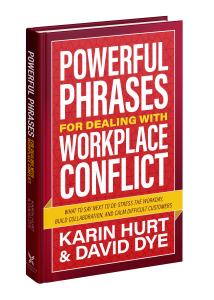 If you’d like more specific, practical phrases and approaches for common sources of workplace conflict, check out our newest book (May 2024—available for pre-order now): Powerful Phrases for Dealing with Workplace Conflict—What to say next to de-stress the workplace, build collaboration, and calm difficult customers.
If you’d like more specific, practical phrases and approaches for common sources of workplace conflict, check out our newest book (May 2024—available for pre-order now): Powerful Phrases for Dealing with Workplace Conflict—What to say next to de-stress the workplace, build collaboration, and calm difficult customers.
The post 12 G.O.A.T. Powerful Phrases to Instantly Boost Your Communication Skills appeared first on Let's Grow Leaders.
April 8, 2024
Conflict at Work: How to Help Your Remote Team Do Conflict Better
We call this conflict cocktail, The “Wedge Driver.
1. Shake up the workforce with remote offices and emerging technologies.
2. Splash the team across time zones and geographies
3. Understaff and overwhelm them as they adapt to rapid change

The pandemic sped up changes in the workforce which has resulted in more conflict at work. More than ever before, people want meaning in their work. And, work itself is changing fast. The World Workplace Conflict and Collaboration results citing continued overwhelm, economic instability, lower levels of motivation, and poor management are symptoms of this upheaval.
Larger organizations have people scattered across seven different time zones. In a world of remote work, many of these people have never met each other in person.
Most managers don’t have formal training on how to deal with such issues (27% of the respondents in our research attribute the increase in conflict to poor management practices).
If you’re in a matrixed organization, it gets more complicated. Lines of responsibility can be fuzzy, and your priorities or incentives might clash with your coworkers’ goals. But you need your coworkers’ help to succeed at your job.
That’s a conflict cocktail.
We don’t share these causes of conflict to discourage you. The point is to understand where the conflict comes from and why it’s happening. When you consider your colleague might be dealing with a ton of unnerving change, it gets easier to show up with compassion and curiosity and look for meaningful solutions.
Understanding the Root Cause of Your Conflict at WorkFirst, acknowledge that the upheaval caused by the pandemic, the transition to remote work, and the rapid technological changes are at the heart of this conflict. This understanding is crucial for approaching the situation with compassion and empathy, recognizing that everyone is navigating their own set of challenges.
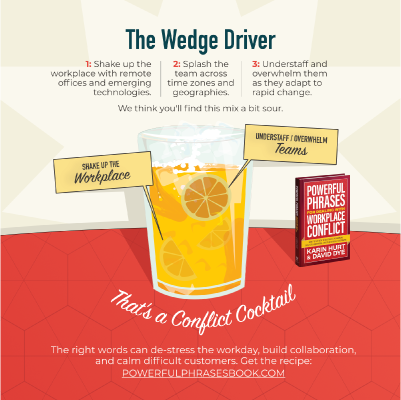 An engaging and light-hearted way to do this is to have your team describe the “conflict cocktails” they’re experiencing now.
An engaging and light-hearted way to do this is to have your team describe the “conflict cocktails” they’re experiencing now.
We’ve created an easy-to-facilitate exercise in our FREE Collaborative Conversations Guide (a companion toolkit to our new book, Powerful Phrases for Dealing with Workplace Conflict).
You can download that for free in our Powerful Phrases Resource Center.
Once you’ve identified the root cause of the issue, you know which of the four dimensions of productive conflict to work on first.
Establishing Connection and ClarityConnection: If you find people are feeling isolated and disconnected, start there. This involves regular check-ins and creating spaces for team members to share both professional updates and personal successes and challenges.
Connection fosters empathy, making it easier to navigate conflicts when they arise.
Here are a few of our favorite Powerful Phrases to create a deeper connection.
“Tell me more…”“It sounds like you’re feeling _______, is that right?”“I care about (you, this team, this project), and I’m confident we can find a solution we can all work with.”Clarity: Ensure clear communication of expectations and roles within the team. Ambiguity can exacerbate feelings of stress and conflict, so making sure everyone understands their responsibilities and how they contribute to the team’s goals is essential.
Remote teams create a whole new set of norms to create clarity around. Make a list of the most important questions to answer. For example:
“Will we require cameras to be on in all video meetings or just certain ones? How do we request an exception?”“How will we make the most of our synchronous time together?“Is it okay to turn on (and share) an AI transcript recording of our meeting?”“When is it appropriate to use messaging versus, email or a phone call?”Promoting Curiosity and CommitmentCuriosity: Encourage a culture of curiosity and open-mindedness. Teach your team some ways to show up more curious in conversation with a genuine desire to understand the other person’s perspective.
A great place to start is to teach each team member a few of our G.O.A.T. (Greatest of All Time) Curiosity Powerful Phrases. Note: You can download a job aid with all 12 of our G.O.A.T.s at our Resource Center.
“I’m curious what this looks like from your perspective?”“What do you suggest we do next?”“What can I do to support you right now?”Commitment: Work together to find solutions that address the underlying issues causing conflict. This may require creative thinking and flexibility, especially in a matrixed organization where priorities and incentives clash.
Once you have some solutions to try, don’t forget to schedule the finish and see how things are working. This G.O.A.T. is a great way to check in to see if your conflict cocktail is getting less intoxicating.This phrases works wonders in creating commitment.
“Let’s schedule some time to talk about this again and see how our solution is working.The best way to address a conflict at work is to get a better understanding of the root cause– to make it easier to talk about the conflict cocktails they are experiencing. And then give them some easy ways to address it. 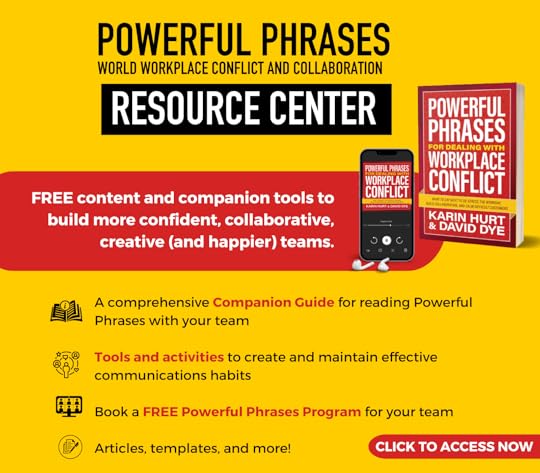
The post Conflict at Work: How to Help Your Remote Team Do Conflict Better appeared first on Let's Grow Leaders.

